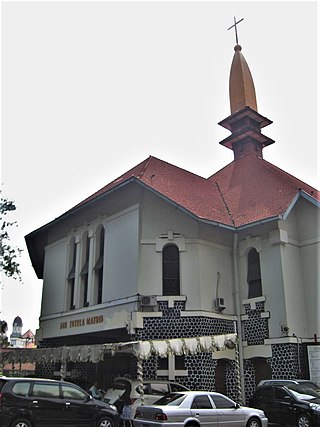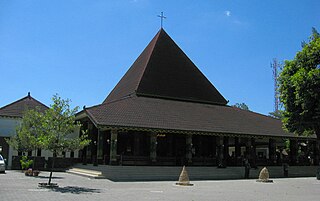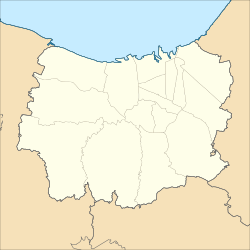
The Catholic Church in Indonesia is part of the worldwide Catholic Church, under the spiritual leadership of the pope in Rome. Catholicism is one of the six approved religions in Indonesia, the others being Islam, Protestantism, Hinduism, Buddhism, and Confucianism. According to official figures, Catholics made up 3.12 percent of the population in 2018. The number of Catholics is, therefore, more than 8.3 million. Indonesia is primarily Muslim, but Catholicism is the dominant faith in certain areas of the country.
Muria Christian Church in Indonesia is one of three Indonesian church synods which are members of Mennonite World Conference (MWC). The church reports more than 16,000 members living in Java, Bali, Sumatra and Kalimantan.
Javanese Mennonite Church is one of three Mennonite-related church synods in Indonesia
In the Catholic Church, a parish is a stable community of the faithful within a particular church, whose pastoral care has been entrusted to a parish priest, under the authority of the diocesan bishop. It is the lowest ecclesiastical subdivision in the Catholic episcopal polity, and the primary constituent unit of a diocese or eparchy. Parishes are extant in both the Latin and Eastern Catholic Churches. In the 1983 Code of Canon Law, parishes are constituted under cc. 515–552, entitled "Parishes, Pastors, and Parochial Vicars."

Christianity is Indonesia's second-largest religion, after Islam. Indonesia also has the second-largest Christian population in Southeast Asia after the Philippines, the largest Protestant population in Southeast Asia, and the third-largest Christian population in Asia after the Philippines and China. Indonesia also has the second-largest Christian population in the Muslim world, after Nigeria, followed by Egypt. Indonesia's 29.4 million Christians constituted 10.47% of the country's population in 2023, with 7.41% Protestant and 3.06% Catholic. Some provinces in Indonesia are majority Christian. In Indonesia, the word Kristen refers to Protestantism, while Catholicism is referred to as Katolik. In the 21st century the rate of growth and spread of Christianity has increased, especially among the Chinese minority.

Protestantism is one of the six approved religions in Indonesia, the others being Islam, Roman Catholicism, Hinduism, Buddhism, and Confucianism. It constitutes the bulk of Christianity in Indonesia, which is the second largest religion in the country after Islam.

Jakarta Cathedral is a Roman Catholic cathedral in Jakarta, Indonesia, which is also the seat of the Roman Catholic archbishop of Jakarta, currently Archbishop Ignatius Suharyo Hardjoatmodjo. Its official name is Gereja Santa Maria Diangkat ke Surga, derived from the original name in Dutch, De Kerk van Onze Lieve Vrouwe ten Hemelopneming. This current cathedral was consecrated in 1901 and built in the neo-Gothic style, a common architectural style to build churches at that time. The Jakarta Cathedral is located in Central Jakarta near Merdeka Square and Merdeka Palace, right in-front of the cathedral stands the Istiqlal Mosque.
Benedictine Sisters of Chicago is a Roman Catholic Benedictine congregation of women. It was founded in 1861 by three sisters of the Benedictine congregation of Mount St. Benedict Monastery in Erie, Pennsylvania, who came to Chicago to teach the German-speaking children of St. Joseph's parish. They became an independent congregation in 1872. St. Scholastica's Monastery in Rogers Park, Chicago is the Motherhouse. St. Scholastica Academy was an integral part of the sisters' ministry in Chicago.
Justinus Cardinal Darmojuwono was an Indonesian cardinal of the Roman Catholic Church. He served as Archbishop of Semarang from 1963 to 1981 and was elevated to the rank of cardinal in 1967, becoming the first Indonesian to be a cardinal.

Franciscus Georgius Josephus van Lith, SJ, or often called Frans van Lith or affectionately Romo van Lith, was a Jesuit priest from Oirschot, Netherlands, who pioneered the Catholic mission in Java, especially Central Java.

The Roman Catholic Archdiocese of Semarang is a Metropolitan Latin archdiocese on Java in Indonesia, yet it depends on the missionary Roman Congregation for the Evangelization of Peoples.
The Indonesian Christian Church Synod abbreviated as Sinode GKI, is an Indonesian church of Presbyterian denomination. It adheres to Calvinist theology, with head office located in Jakarta.

The Church of the Sacred Heart of Jesus is a Roman Catholic parish church, located in Hell's Kitchen/Clinton, Manhattan, New York City. Founded in 1876, it is a parish of the Archdiocese of New York and is located at 457 West 51st Street. Sacred Heart of Jesus School is located at 456 West 52nd Street.
Joseph Kam was a Dutch missionary in Indonesia.

The Protestant Church in Western Indonesia Immanuel Semarang, better known as Blenduk Church, is a Protestant church in Semarang, Central Java, Indonesia. Built in 1753, it is the oldest church in the province.

Albertus Soegijapranata, SJ, better known by his birth name Soegija, was a Jesuit priest who became the Apostolic Vicar of Semarang and later its archbishop. He was the first native Indonesian bishop and known for his pro-nationalistic stance, often expressed as "100% Catholic 100% Indonesian".

The Church of the Sacred Heart of Jesus, also known as the Ganjuran Church, is a Roman Catholic church located in Ganjuran, Bantul, Special Region of Yogyakarta, Indonesia. It is the oldest church in its administrative regency.

The Cathedral of the Virgin Mary, Queen of the Holy Rosary, also known as the Holy Rosary Cathedral or Randusari Cathedral, is a Roman Catholic cathedral and the seat of the Archdiocese of Semarang. Finished in 1927 at Randusari, Semarang, Indonesia, it became a parish church in 1930 and a cathedral in 1940, when Albertus Soegijapranata was made the first archbishop of Semarang.
Mgr. Adrianus Djajasepoetra, SJ, was an Indonesian Roman Catholic prelate who served as the Vicar Apostolic of Jakarta and later its Archbishop (1953–1970). Before being a Vicar Apostolic, Mgr. Adrianus was a Rector of St. Ignatius College, Yogyakarta and the 4th Rector of Major Seminary, Kentungan, Yogyakarta (1948-1949).














